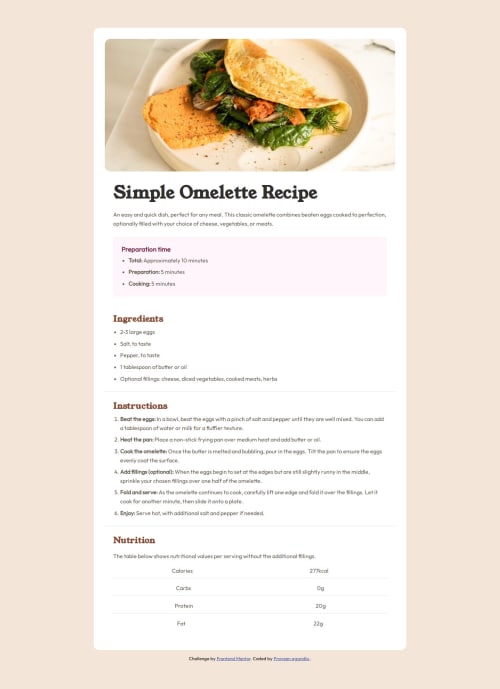Mobile first page recipe page using HTML,CSS

Please log in to post a comment
Log in with GitHubCommunity feedback
- @https429
Hey there, Boss!
Your code is already pretty solid, but there are always ways to improve or tweak things. Here are a few suggestions:
-
Alt Text for Images: You've got an image tag with an empty
altattribute. It's a good practice to provide descriptive alt text for images. This helps with accessibility and SEO. For example, you could usealt="Omelette". -
Semantic HTML: Consider using more semantic HTML tags. For example, you could use
<section>tags to group related content together, like the ingredients and instructions. This can improve accessibility and SEO. -
CSS Variables: You're using some colors multiple times in your CSS. You could define these as CSS variables at the top of your file. This makes it easier to maintain and change your color scheme.
-
Font Loading: You're loading two different fonts using
@font-face. Consider using a service like Google Fonts or Adobe Fonts. They can handle the font loading for you and can help improve performance. -
Responsive Design: You've got a media query for screens larger than 768px, which is great! You might want to consider adding more breakpoints for different screen sizes to make your design even more responsive.
-
CSS Organization: Consider organizing your CSS in a more structured way. You could group styles by component or follow a methodology like BEM or SMACSS.
Remember, these are just suggestions. Your code is already pretty good! Keep up the good work, mate! 🚀
-
Join our Discord community
Join thousands of Frontend Mentor community members taking the challenges, sharing resources, helping each other, and chatting about all things front-end!
Join our Discord